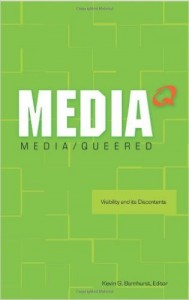 Media Queered: Visibility and its Discontents
Media Queered: Visibility and its Discontents
Edited by Kevin G. Barnhurst
Peter Lang Publishing Group. 298 pages, $89.95 ($32.95 paper)
IN APRIL 1954, Los Angeles television station KTTV aired a segment called “The Sex Variant in Southern California,” which for the first time allowed an openly gay man to describe his life to the general public on his own terms. After presenting unsympathetic interviews with a psychologist and a police officer, the talk-show host introduced a 22-year-old gay man, pseudonymously dubbed “Curtis White.” They asked if he wished he could be transformed into a heterosexual. White said no.
Much has changed since that landmark moment in American broadcasting. Queer people have gone from asserting our right to existence to seeing our most intimate activities made fodder for steamy primetime soap operas such as Queer as Folk and The L Word. Our community media have expanded: earnestly typeset political broadsheets have been replaced by glossy lifestyle magazines directed at GLBT consumers. In addition to unprecedented access to mainstream publishing and broadcasting, gay people have taken the Internet by storm, using new forms of media to organize for both politics and pleasure.
Documenting this shift is the aim of Media Queered: Visibility and its Discontents, a new collection of essays that explore the tensions and contradictions of queer people’s changing relationship to mass media and popular culture. Assembled by communications professor Kevin G. Barnhurst, the featured papers come from a seminar he taught on media visibility at the University of Illinois at Chicago. Barnhurst locates their subject matter “at the nexus of media studies and queer studies.” The contributors, two dozen academics and media practitioners, offer a wide range of perspectives on the role of media in the lives of gay people historically and to the present day. Interspersed with the academic papers is a series of first-person essays referred to as “interludes.” Written by such luminaries as veteran journalist and social historian Studs Terkel and longtime GLBT publisher Tracy Baim, these pieces include some of the book’s most striking insights.
Some of Media Queered’s contributions reveal little-known moments in media history, such as the KTTV show noted above, which is discussed by Edward Alwood in “A Gift of Gab: How Independent Broadcasters Gave Gay Rights Pioneers a Chance to Be Heard.” Marguerite Moritz offers some perspective on recent struggles around media coverage of gay marriage by exploring the decision by the tiny Salina Journal in rural Kansas to run an announcement about a local gay couple’s (non-legal) marriage—back in 1993. Other stimulating entries include a discussion of queer visibility and its relationship to social and economic class, examinations of queer youth in the on-line world, and a fascinating discussion of how parenting and gay men’s relationships with straight women are re-imagined and depicted in film.
For the most part, the essays are straightforward and easily accessible to either academic or lay audiences. There are a couple of exceptions, however. The old creative writing dictum to “show” rather than “tell” can also be applied to academic writing, and in a few cases this would have resulted in shorter, more persuasive essays. In Han N. Lee’s “Queering Race in Cyberspace,” for instance, the author spends so much time setting up the theoretical framework through which he intends the reader to understand his work that when he finally presents his results, they underwhelm.
One incongruous note sounded in Media Queered is the short essay by libertarian economist Deirdre McCloskey, “Queer Markets.” McCloskey’s piece is intended as the introduction to a section discussing queer engagement with mainstream versus GLBT media, and participation both within and outside the system in terms of media advocacy. The essay barely touches these issues, however, instead making the case that the free market is the most productive space for queer liberation. Ironically, though, the section’s excellent analysis by Katharine Sender called “Professional Homosexuals” shows clearly how the systemic inequities of the marketplace affect queer people—especially lesbians and people of color—differently from how they affect straight people.
Few first books on any given topic are comprehensive, but Media Queered offers a great starting point. A couple of contributions, such as Gavin Jack’s “A Case of Whorephobia?” and especially Amit Kama’s review of Israeli gay men’s consumption of local queer media, feel like orphans in the sense that their subject matter is so unlike the rest of the book, which has a wholly American focus and is less directly concerned with the politics of explicit sexual liberation. These contributions hint at a broader range of concerns about gay people in the media that needs further consideration. Barnhurst will have no trouble finding further areas of dissent and debate when it’s time to deliver a follow-up volume.
____________________________________________________________________
Shawn Syms is a Toronto-based author of essays, reviews, and fiction.





